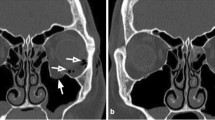Abstract
Orbital imaging plays a pivotal role in each hospital with an Ophthalmological Emergency Department. Unenhanced orbital computed tomography (CT) usually represents the first-line tool for the assessment of nontraumatic orbital emergencies, thanks to its quick execution, wide availability, high resolution, and availability of multiplanar reformats/reconstructions. Magnetic resonance imaging (MRI) is an essential tool that allows characterization and a better understanding of the anatomical involvement of different disorders due to its excellent contrast resolution and ability to study the visual pathways, even if, unfortunately, it is not always available in the emergency setting. It represents the first imaging choice in pediatric patients, due to the absence of ionizing radiation. When available, CT and MRI are often used together to diagnose, assess the extent, and provide treatment plans for various orbital nontraumatic emergencies, including infective, inflammatory, vascular, and neoplastic diseases. Familiarity with the imaging appearances of these disorders helps the radiologists to establish the correct diagnosis in the emergency setting, which contributes to timely clinical management. This pictorial essay provides a description of the clinical presentation and imaging findings of nontraumatic orbital emergencies.















Similar content being viewed by others
References
Cellina M, Floridi C, Panzeri M, Giancarlo O (2018) The role of computed tomography (CT) in predicting diplopia in orbital blowout fractures (BOFs). Emerg Radiol 25:13–19. https://doi.org/10.1007/s10140-017-1551-1
LeBedis CA, Sakai O (2008) Nontraumatic orbital conditions: diagnosis with CT and MR imaging in the emergent setting. Radiographics 28:1741–1753. https://doi.org/10.1148/rg.286085515
Nguyen VD, Singh AK, Altmeyer WB, Tantiwongkosi B (2017) Demystifying orbital emergencies: a pictorial review. Radiographics 37:947–962. https://doi.org/10.1148/rg.2017160119
Gospe SM, Bhatti MT (2018) Orbital Anatomy. Int Ophthalmol Clin 58:5–23. https://doi.org/10.1097/IIO.0000000000000214
Ferreira TA, Saraiva P, Genders SW, Buchem MV, Luyten GPM, Beenakker J-W (2018) CT and MR imaging of orbital inflammation. Neuroradiology 60:1253–1266. https://doi.org/10.1007/s00234-018-2103-4
Eissa L, Abdel Razek AAK, Helmy E (2021) Arterial spin labeling and diffusion-weighted MR imaging: utility in differentiating idiopathic orbital inflammatory pseudotumor from orbital lymphoma. Clin Imaging 71:63–68. https://doi.org/10.1016/j.clinimag.2020.10.057
Limone PP, Bianco L, Mellano M, Garino F, Giannoccaro F, Rossi A, Airaldi C, Nassisi D, Gino E, Deandrea M, Oldani B, Ruo Redda MG (2021) Is concomitant treatment with steroids and radiotherapy more favorable than sequential treatment in moderate-to-severe graves orbitopathy? Radiol Med 126:334–342. https://doi.org/10.1007/s11547-020-01244-5
de Arcaya AA, Cerezal L, Canga A, Polo JM, Berciano J, Pascual J (1999) Neuroimaging diagnosis of Tolosa-Hunt syndrome: MRI contribution. headache. J Head Face Pain 39:321–325. https://doi.org/10.1046/j.1526-4610.1999.3905321.x
Cellina M, Pirovano M, Ciocca M, Gibelli D, Floridi C, Oliva G (2021) Radiomic analysis of the optic nerve at the first episode of acute optic neuritis: an indicator of optic nerve pathology and a predictor of visual recovery? Radiol Med 126:698–706. https://doi.org/10.1007/s11547-020-01318-4
Cellina M, Fetoni V, Ciocca M, Pirovano M, Oliva G (2018) Anti-myelin oligodendrocyte glycoprotein antibodies: magnetic resonance imaging findings in a case series and a literature review. Neuroradiol J 31:69–82. https://doi.org/10.1177/1971400917698856
Eustis HS, Mafee MF, Walton C, Mondonca J (1998) MR imaging and CT of orbital infections and complications in acute rhinosinusitis. Radiol Clin North Am 36:1165–1183. https://doi.org/10.1016/S0033-8389(05)70238-4
Cellina M, Fetoni V, Baron P, Orsi M, Oliva G (2015) Listeria meningoencephalitis in a patient with rheumatoid arthritis on anti–interleukin 6 Receptor Antibody Tocilizumab. JCR J Clin Rheumatol 21:330. https://doi.org/10.1097/RHU.0000000000000287
Van Tassel P, Lee Y, Jing B, De Pena C (1989) Mucoceles of the paranasal sinuses: MR imaging with CT correlation. Am J Roentgenol 153:407–412. https://doi.org/10.2214/ajr.153.2.407
Moulin G, Pascal T, Jacquier A, Vidal V, Facon F, Dessi P, Bartoli JM (2003) Imagerie des sinusites chroniques de l’adulte [Radiologic imaging of chronic sinusitis in the adult]. J Radiol 84:901–919
Kohanim S, Daniels AB, Huynh N, Eliott D, Chodosh J (2012) Utility of ocular ultrasonography in diagnosing infectious endophthalmitis in patients with media opacities. Semin Ophthalmol 27:242–245. https://doi.org/10.3109/08820538.2012.711417
Bhardwaj G, Chowdhury V, Jacobs MB, Moran KT, Martin FJ, Coroneo MT (2010) A systematic review of the diagnostic accuracy of ocular signs in pediatric abusive head trauma. Ophthalmology 117:983-992.e17. https://doi.org/10.1016/j.ophtha.2009.09.040
Conart J-B, Berrod J-P (2016) Hémorragies du vitré non traumatiques. J Fr Ophtalmol 39:219–225. https://doi.org/10.1016/j.jfo.2015.11.001
Halbach V, Hieshima G, Higashida R, Reicher M (1987) Carotid cavernous fistulae: indications for urgent treatment. Am J Roentgenol 149:587–593. https://doi.org/10.2214/ajr.149.3.587
Tailor TD, Gupta D, Dalley RW, Keene CD, Anzai Y (2013) Orbital neoplasms in adults: clinical, radiologic, and pathologic review. Radiographics 33:1739–1758. https://doi.org/10.1148/rg.336135502
Nagesh C, Rao R, Hiremath S, Honavar S (2021) Magnetic resonance imaging of the orbit, part 2: characterization of orbital pathologies. Indian J Ophthalmol 69:2585. https://doi.org/10.4103/ijo.IJO_904_21
Author information
Authors and Affiliations
Corresponding author
Ethics declarations
Ethics approval and consent to participate
The images included in this educational article belong to an IRB study approved on February 19, 2019; Experimentation Register Number 2018/ST/191, approved by the Ethics Committee Sacco Area 1, Milan, Italy. The patients provided written consent for the use of their anonymized images.
Conflict of interest
The authors declare that they have no conflict of interest.
Additional information
Publisher's note
Springer Nature remains neutral with regard to jurisdictional claims in published maps and institutional affiliations.
Rights and permissions
About this article
Cite this article
Cellina, M., Cè, M., Irmici, G. et al. Nontraumatic orbital emergencies: a pictorial essay — CT and MRI features for an imaging findings-based approach. Emerg Radiol 29, 769–780 (2022). https://doi.org/10.1007/s10140-022-02047-z
Received:
Accepted:
Published:
Issue Date:
DOI: https://doi.org/10.1007/s10140-022-02047-z




